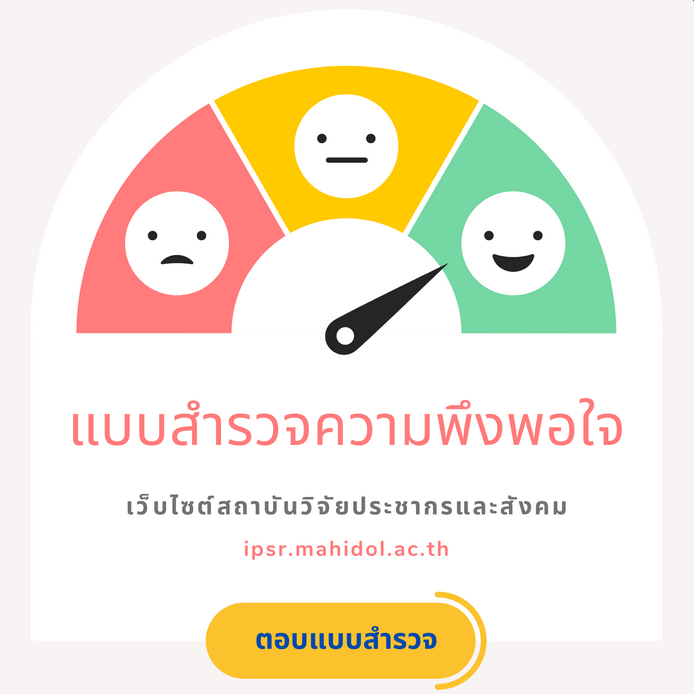Population of Thailand, 2024
(Vol.33 : January 2024)
Estimated Population at Midyear 2024 (1st July)
| Objectives |
| IPSR publishes the “Mahidol Population Gazette” in January annually in both Thai and English versions to disseminate estimated population indicators. All figures are updated each year based on the most recent information available. Therefore, the data in the “Mahidol Population Gazette” of different years should not be analyzed to determine population trends. |
| Male | Female | Total | ||
|---|---|---|---|---|
| 1 | Total Population (x 1,000) | 31,694 | 34,173 | 65,867 |
| 2 | Population by Area of Residence (x 1,000) | |||
| Urban area (population living in all types of cities and municipal areas) | 19,662 | 21,230 | 40,892 | |
| Rural area (population living outside urban areas) | 12,032 | 12,943 | 24,975 | |
| 3 | Population by Region (x 1,000) | |||
| Bangkok Metropolis | 3,989 | 4,327 | 8,316 | |
| Central (excluding Bangkok Metropolis) | 9,590 | 10,290 | 19,880 | |
| Northern | 5,108 | 5,573 | 10,681 | |
| Northeastern | 8,518 | 9,232 | 17,750 | |
| Southern | 4,489 | 4,751 | 9,240 | |
| 4 | Population by Age Group (x 1,000) | |||
| Children (under 15 years) | 5,028 | 4,791 | 9,819 | |
| Labor force (15-59 years) | 20,811 | 21,281 | 42,092 | |
| Older persons (60 years and over) | 5,855 | 8,101 | 13,956 | |
| Older persons (65 years and over) | 3,749 | 5,621 | 9,370 | |
| Pre-school ages (0 – 5 years) | 1,668 | 1,588 | 3,256 | |
| School ages (6-21 years) | 6,231 | 5,950 | 12,181 | |
| Women of reproductive age (15-49 years) | 15,782 | |||
| 5 | Life Expectancy at Birth | Male 71.9 years | ||
| (average number of years a person could expect to live after birth) | Female 79.9 years | |||
| 6 | Life Expectancy at Sixty | Male 17.4 years | ||
| (average number of years a person could expect to live after age sixty) | Female 23.1 years | |||
| 7 | Life Expectancy at Eighty | Male 5.8 years | ||
| (average number of years a person could expect to live after age eighty) | Female 8.3 years | |||
| 8 | Vital Rates | |||
| Crude birth rate (per 1,000 population) | 6.7 | |||
| Crude death rate (per 1,000 population) | 9.1 | |||
| Natural growth rate (percent) | -0.2 | |||
| Infant mortality rate (per 1,000 live births) | 7.3 | |||
| Child (under 5) mortality ratio (per 1,000 live births) | 10.5 | |||
| 9 | Total Fertility Rate (average number of children a woman would have throughout her reproductive years) | 1.0 | ||
| 10 | Contraceptive Prevalence Rate (percent) | 73.0 | ||
| 11 | Ageing Index (percent) | 142.1 | 116.4 | 169.1 |
| Sources of Data |
| – Report on the Multiple Indicator Cluster Survey 2019, National Statistical Office & UNICEF. – Population and Housing Census 2010, National Statistical Office. – The 2021 Survey of the Older Persons in Thailand, National Statistical Office. – Report on Population Projections for Thailand 2010 – 2040 (Revised), Office of the National Economic and Social Development Council – Bureau of Registration and Administration, Department of Local Administration, Ministry of Interior. |
| Notes on data |
| – Population in Listing 1-4 : Thais and non-Thais whose names are in household registration. – Crude Birth Rate (per 1,000 population) : Number of births in one year divided by midyear population and multiplied by 1,000. – Crude Death Rate (per 1,000 population) : Number of deaths in one year divided by midyear population and multiplied by 1,000. – Natural Growth Rate (percent) : Number of births minus number of deaths divided by midyear population and multiplied by 100. – Infant Mortality Rate (per 1,000 live births) : Number of deaths of infants under age 1 in one year divided by total live births in that year and multiplied by 1,000. – Child (under 5) Mortality Ratio (per 1,000 live births) : Number of deaths of children under age 5 in one year divided by total live births in that year and multiplied by 1,000. – Total Fertility Rate (TFR) : Average number of children a woman would have throughout her reproductive years, calculated by summing the age-specific fertility rates of women of reproductive age. – Contraceptive Prevalence Rate : Percent of currently married women age 15 – 49 using contraception. – Ageing Index (percent) : Number of persons aged 60 years and over divided by number of population under age 15 and multiplied by 100. |
